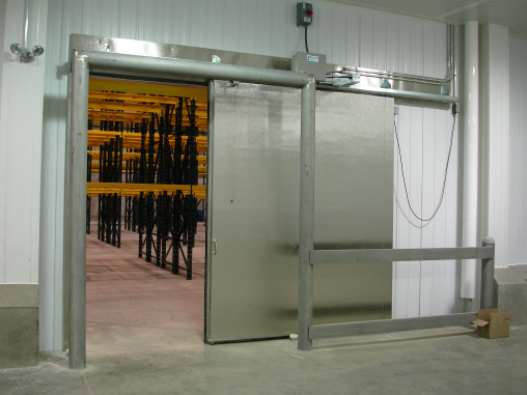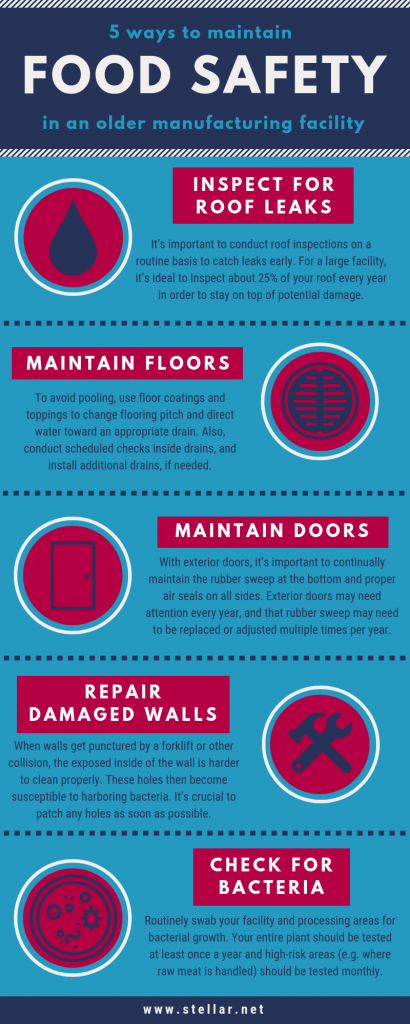You don’t need to build a brand new facility to meet modern-day food safety standards. The reality is that most companies don’t have the budget to build from scratch as often as they’d like, but that doesn’t mean your decades-old plant can’t be a shining example of food safety.
Let’s look at five things you can do now to ensure your older facility is up to today’s food safety standards.
1. Inspect for roof leaks regularly
Roof leaks can create major issues in your facility in more ways than one. Leaks can foster mold and bacterial growth, alter the ambient temperature and introduce external contaminants. It doesn’t have to be a giant hole in the ceiling, either — relatively small leaks can wreak havoc.
It’s important to conduct roof inspections on a routine basis to catch leaks early. Once a leak is noticeable inside a building, damage has already been done. Roof inspections and roof perimeter inspections can be handled by local maintenance teams, but large roofing companies often provide maintenance services as well.
You don’t necessarily have to do a full inspection of your entire roof every year, but for a large facility it’s ideal to inspect about 25 percent of your roof every year in order to stay on top of potential damage.
If you do have a leaky roof, the number-one goal of your maintenance group is to get a quick fix in place. What that fix is depends on the roof structure in place. One thing to keep in mind with large roof systems is that a visible drip could actually be originating from a leak that’s a hundred feet away and can be extremely hard to find.
2. Maintain floors and avoid pooling water
Flooring cracks and other issues are common in older food facilities, and the more they are neglected, the larger they can get. These issues are typically pretty evident because cracks are visible and it’s fairly easy to spot pooling water.
If you’re avoiding digging up the entire floor, one “quick fix” is using floor coatings and toppings to areas of the floor to change its pitch and direct water toward an appropriate drain.
It’s common for flooring to crack around drains due to thermal expansion, so it’s important to maintain these to avoid dangerous levels of listeria and erosion under the slab. Especially in older buildings, I recommend running a vision system (CCTV) down a certain percentage of your drains and developing a baseline. Then, conduct scheduled checks for any material break down, rotting or buildup. There are many solutions to repairing in-floor or underground piping, and your piping system may require a specific solution as all defects and piping materials are likely different.
You can also install additional drains; although this requires digging up the floor a little bit, it’s not as much as a full flooring overhaul. If you can’t get proper drainage by engineering a fix, you can always have plant personnel squeegee and mop floors to prevent pooling water.
Of course, if you have serious drainage issues, these suggestions are only buying you time for the inevitable reality of redoing your flooring system. Remember: Standing water is not acceptable in any facility.
3. Maintain door seals and sweeps
Your facility’s doors are critical to food safety because they can present a major, ongoing risk for contamination. Interior facility doors should be in proper operating condition and have proper air seals on all four sides. With exterior doors, it’s important to continually maintain the rubber sweeps at the bottom.
A good way to test the seal at the bottom of your doors is to try to fit a piece of paper under the door or shine a flashlight at it. If you can slip a sheet of paper through or if you can see the light from the other side, that’s a red flag. Exterior doors may need attention every year, and that rubber sweep may need to be replaced or adjusted multiple times per year.
4. Repair damaged walls immediately
One of the biggest food safety problems I see with walls is the damage that forklifts and people do to them. When these walls get punctured by a forklift or other collision, you expose the inside of the wall, making it harder to clean properly. These holes then become susceptible to harboring bacteria.
Insulated metal panels (IMP) and porous concrete block are both equally vulnerable to damage and harborage, so it’s crucial to patch any holes as soon as possible to ensure any contamination stays on the surface.
If you swab your facility’s walls, it is unlikely there will be a population of listeria or other bacterial growth there, assuming it has the integrity it had when it was new. However, outbreaks are more common in the spaces between the wall and floor, especially if it hasn’t been properly caulked, covered and maintained over time. That brings me to my final point:
5. Conduct routine surveys for bacterial growth
These surveys ought to be done on an ongoing basis by your quality assurance department or maintenance/engineering teams. Most companies should have a routine swabbing program to test processing areas.
Larger companies may have lab technicians on staff who have regular swabbing routes, but smaller operations can turn to a third-party partner to conduct regular testing. When possible, I think these surveys are best conducted in-house, because it allows you to control the solutions and discussions that take place about your facility and its cleanliness.
These surveys should be process risk-based: Consider the greatest risk of your process and make that the priority. For example, you’re going to do things differently if your process raw meat and poultry versus a fried snack item. Your entire plant should be tested at least once a year and high-risk areas (e.g., where raw meat is handled) should be tested monthly. Of course, if test results are atypical in a particular area, that area will be tested more frequently until the results return to normal.
What steps have you taken to keep your facility food safe? Let me know in the comments below or send me your questions at foodforthought@stellar.net




